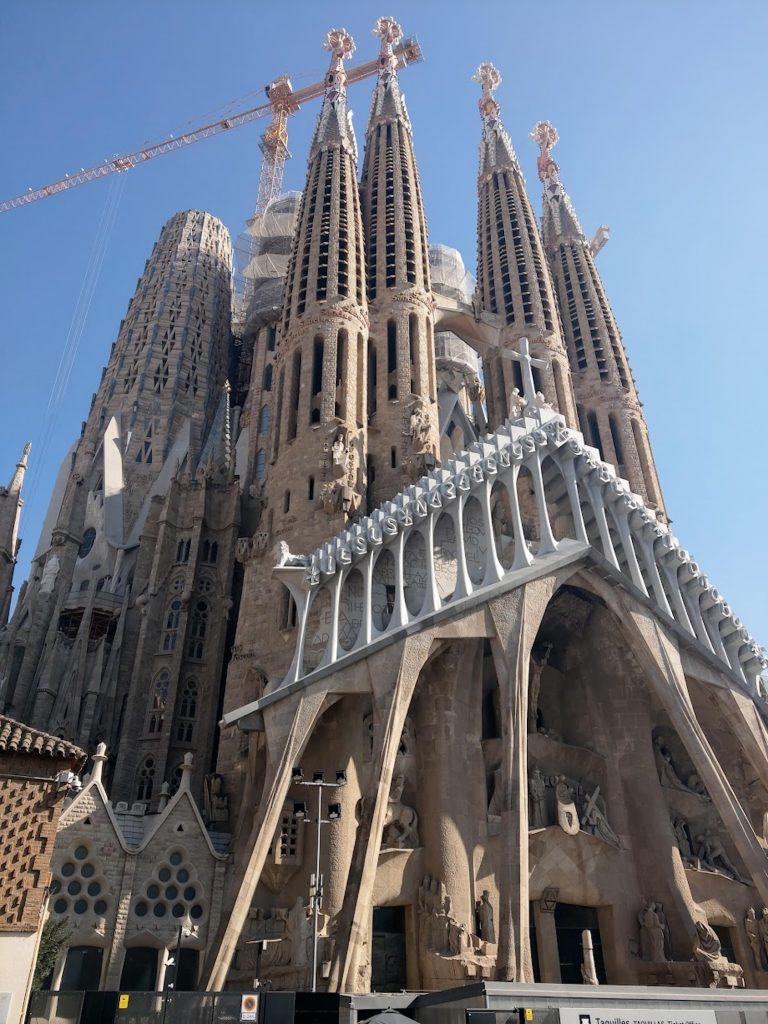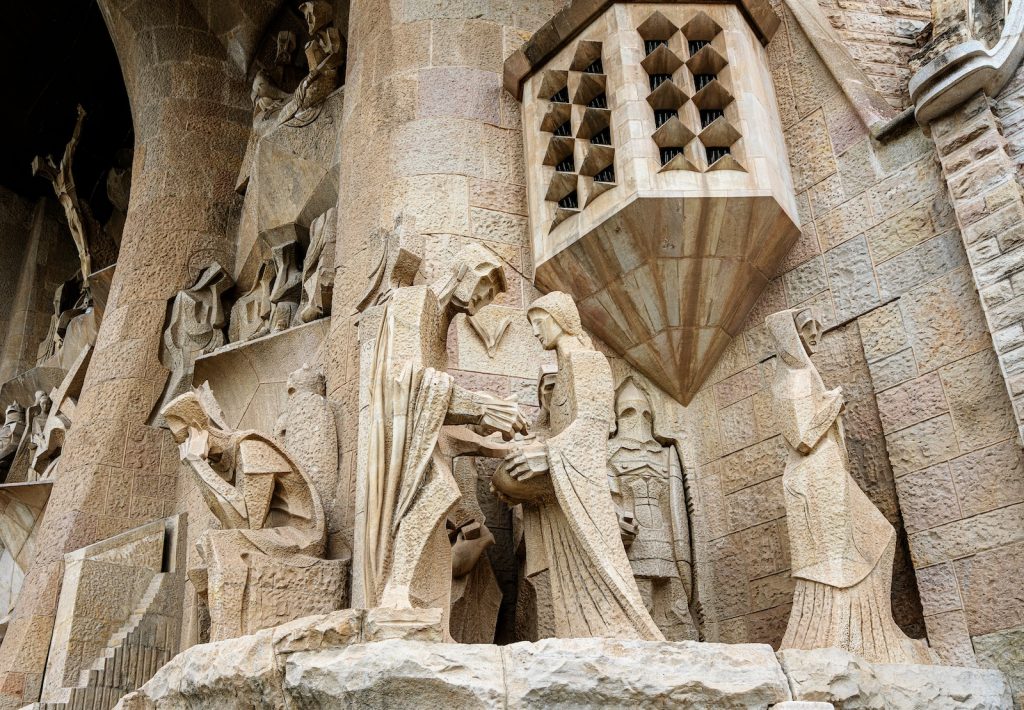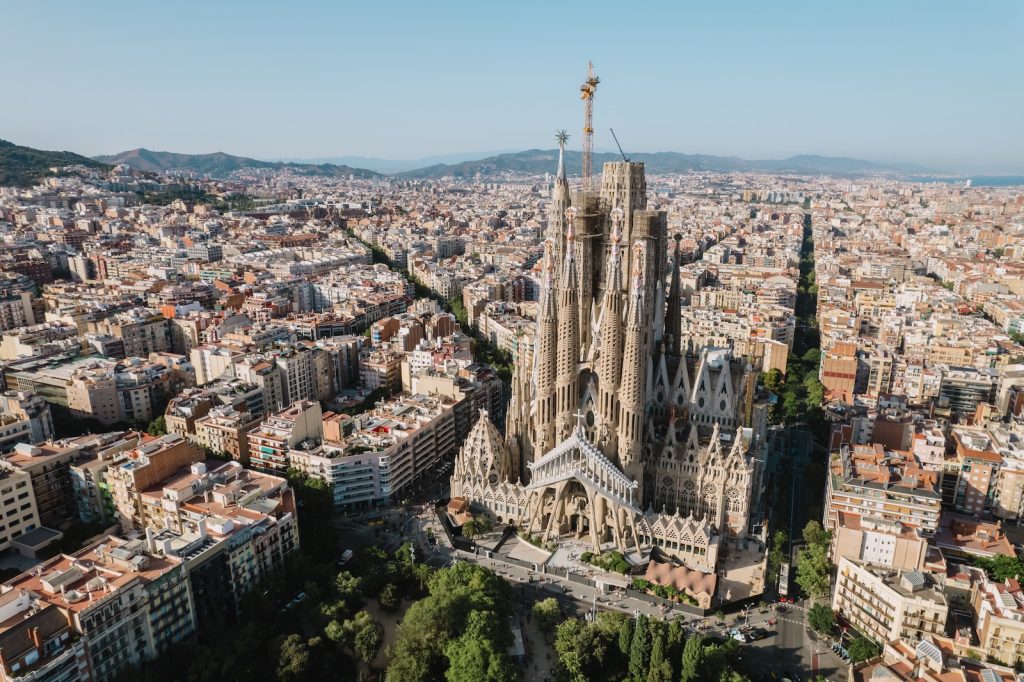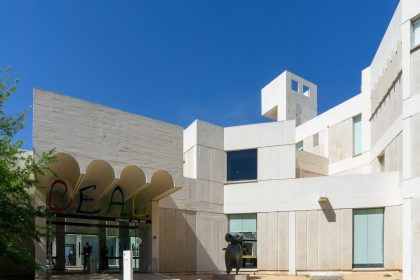Sagrada Familia is a place that literally takes your breath away. When I first stood before this monumental structure, I felt as though time had stopped for a moment. I never thought something could be so grand yet so full of subtle details. The genius of Antonio Gaudí is evident at every step – from the towering spires that seem to touch the sky to the intricately decorated facades that tell stories.
By purchasing tickets through my links, you save time, money, avoid queues, and help me grow my blog. Thank you in advance! 😘
Anyone who has seen the Sagrada Familia even once knows that it’s more than just a church. It’s a living work of art that grows with each passing year, and the fact that it’s still unfinished adds an extra aura of mystery to the place. You could say it’s Barcelona’s “never-ending story.”

What surprised me the most was how light fills the interior of this basilica. Upon entering, you feel as though you’ve stepped into a forest of light – the colorful stained glass windows make the entire interior glow in shades of blue, red, and gold. It’s truly a place that everyone should see with their own eyes, as no photo can capture its magic.
For me, the Sagrada Familia is more than just a historic site. It’s a symbol of endless creativity and the patience required to create masterpieces.
A Brief History of the Sagrada Familia
The history of the Sagrada Familia is as fascinating as the basilica itself. It all began in 1882, when the decision was made to build this impressive temple. The initial design followed a classical neo-Gothic style, but everything changed when Antoni Gaudí took over the project in 1883. It was his vision that transformed the building into something the world had never seen before.
Gaudí devoted more than 40 years of his life to this project, with the last 15 years spent working exclusively on the Sagrada Familia. It is said that the basilica was his “life and passion,” which is evident in every detail. Gaudí believed that the construction of this masterpiece could take hundreds of years, and he wasn’t wrong – it remains unfinished to this day, with plans to complete it by 2026, marking the 100th anniversary of Gaudí’s death.
What surprised me most is the fact that Gaudí knew from the start that he would not see his work fully completed. Nevertheless, he designed the plans in such detail that his vision has survived for decades and is being carried forward by successive generations of architects. Construction has been interrupted by wars, financial crises, and other challenges, yet Gaudí’s spirit still hovers over the place, making it even more extraordinary.
When visiting the Sagrada Familia, you can’t help but appreciate the history and perseverance behind this building. It’s a place that feels like a living organism, growing, evolving, and inspiring everyone who has the chance to see it.
Antoni Gaudí – Genius and Visionary
When I think of the Sagrada Familia, I immediately think of Antoni Gaudí – a man who not only designed this extraordinary church but also dedicated his entire life to making his vision a reality. Gaudí was not just an architect; he was a true artist, who saw architecture as a combination of nature, art, and religion.
Born in 1852 in Catalonia, Gaudí was fascinated by nature and geometry from a young age. His love for organic forms, evident in his projects, made him one of the most innovative architects of his time. Interestingly, the Sagrada Familia is not only the most important work of his life but also a true reflection of his faith and philosophy.
Gaudí was a deeply religious man, and he viewed the Sagrada Familia as an act of worship to God. He created a design so complex and unique that every element had its symbolic meaning. From the 18 towers, symbolizing Jesus, Mary, the 12 apostles, and the four evangelists, to the facades depicting key events from the life of Christ – everything was designed with deep spirituality and meticulous attention to detail.
The most extraordinary aspect is that Gaudí lived with the conviction that his work would only be completed long after his death. In 1926, he tragically died after being hit by a tram, and his body now rests in the crypt of the Sagrada Familia – a place that has become his most enduring legacy.
For me, Gaudí is a true genius, who not only was ahead of his time but also left behind something that continues to inspire generations. Walking through the Sagrada Familia, you feel that you are part of something greater – a vision that transcends time and space.
Architecture: What Makes the Sagrada Familia So Unique?
The Sagrada Familia is a masterpiece that defies all the rules of traditional architecture. Every element of this church is thought out, yet surprisingly organic. Drawing inspiration from nature, Gaudí created something that looks like a living organism – growing, changing, pulsating with light and color.
By purchasing tickets through my links, you save time, money, avoid queues, and help me grow my blog. Thank you in advance! 😘
The exterior facade is truly a story carved in stone. Each of the three main facades has its own meaning: Nativity, Passion, and Glory of Christ. What struck me the most was the Nativity Facade, which is full of details inspired by nature – flowers, leaves, birds, and even animals. Every fragment of this facade has significance and tells the story of Jesus’ birth. In contrast, the Passion Facade is more austere, with sharp lines that convey the tragedy of the events.
When I crossed the threshold and entered the interior of the Sagrada Familia, I felt like I was stepping into a magical forest. The basilica’s interior is simply incredible. The columns resemble trees, and the ceiling above them represents tree canopies through which light streams. Gaudí created what he called a “temple of light,” and it’s truly visible – the stained glass plays with light, filling the entire space with colors. What enchanted me the most was how the light changes throughout the day – in the morning, cool shades of blue and green dominate, while in the evening, the basilica glows with warm hues of red and orange.

One cannot forget about the towers – they are what give the Sagrada Familia its iconic silhouette. Each one symbolizes a different saint or apostle, and from the Jesus Christ Tower, you can enjoy a panoramic view of the entire city of Barcelona. Gaudí designed these towers so that their height would integrate with the city’s landscape, but at the same time, not overshadow the mountains in the background, because as he said, “the work of man should never surpass the work of God.”
For me, the architecture of the Sagrada Familia is a blend of nature, art, and spirituality. Every detail has its significance, and the entire church feels alive and full of energy. Gaudí created something that surpasses ordinary architecture – it’s a place that captivates and inspires at every turn.
My impressions upon entering the Sagrada Familia
Even approaching the Sagrada Familia stirs excitement. As soon as I stood before its monumental towers, I knew I was about to experience something truly exceptional. However, the real magic begins when you cross the threshold and step inside.
The first thing that struck me upon entering was the incredible play of light. The stained glass windows allow sunlight to pour in, creating a kaleidoscope of colors – from deep blues and greens to warm hues of red and gold. It was stunning! I felt as though I had stepped into a forest, where light filters through the leaves, creating a unique atmosphere. Truly, this cannot be captured in photos – you have to see it with your own eyes.
One of the most remarkable elements of the interior is the columns, which resemble trees. They are designed to support the roof in a way that mimics nature. Gaudí was inspired by the forest, and the effect is mesmerizing. Walking through the naves, I felt as though I was inside a giant, organic structure – one that is alive and breathing.
By purchasing tickets through my links, you save time, money, avoid queues, and help me grow my blog. Thank you in advance! 😘
Another thing that amazed me was the peace and quiet inside the basilica, despite the crowds of tourists. Everyone who enters feels the need to calm down and admire this masterpiece with respect. This was surprising to me, because despite its popularity, the Sagrada Familia hasn’t lost the spiritual aura that Gaudí so carefully planned.
During the visit, I also recommend using the audio guide. I was surprised by how many interesting details you can discover by listening to the story behind each element. For example, I learned that the columns are designed not only to resemble trees but also to incorporate mathematical patterns, which Gaudí integrated into his vision.
In summary, entering the Sagrada Familia felt like crossing the boundary between the real world and something almost mystical. It’s not just an ordinary church – it’s an experience that stays with you for a long time.
The Best Time to Visit
If you’re planning to visit the Sagrada Familia, choosing the right time is key. I learned this firsthand when my first visit was at noon during peak season – the crowds of tourists and the scorching sun took away some of the charm of this unique place. So, if I can offer some advice, it’s to visit either in the morning or late afternoon.
In the morning, right after opening, there are definitely fewer people, and the basilica is surrounded by an aura of tranquility and silence. It’s the perfect time to walk around the interior and enjoy the play of light, which then enters through the eastern stained glass windows, casting cool blue-green reflections.
On the other hand, the afternoon, especially the later hours, is a magical moment when the setting sun transforms the interior into a golden-red sea of light. This is my favorite time – the light passes through the stained glass on the western facade, creating a warm, cozy atmosphere that makes the entire interior look as if it’s illuminated by flames.

If you want to avoid the crowds, book your tickets online in advance. When I chose the guided tour option, I had the chance to learn many interesting things, but if you prefer a more relaxed visit, the audio guide works great too.
Lastly, if you enjoy taking photos, consider the lighting. In the morning, you’ll get softer and cooler colors, while in the evening, warmer tones, perfect for capturing the magical shots of the interior. It’s definitely worth visiting twice to experience the Sagrada Familia at different times of the day!
Is it worth going up the towers? My impressions from the top
If you’re wondering whether it’s worth going up the towers of the Sagrada Familia, my answer is: absolutely yes! For me, it was one of the most exciting parts of the visit, though I’ll admit I had some slight concerns about the height. However, the views waiting at the top completely make up for every moment of the climb!
By purchasing tickets through my links, you save time, money, avoid queues, and help me grow my blog. Thank you in advance! 😘
Going up the towers is not only a great opportunity to admire the panoramic views of Barcelona, but also to get a closer look at the architectural details of the Sagrada Familia, which can be hard to notice from the ground. Each tower is unique, and Gaudí designed them with attention to even the smallest details.
My advice? Choose the Nativity Tower if you’re interested in seeing more classic, organic details inspired by nature, and the Passion Tower if you want to experience something more austere and symbolic. I opted for the Nativity Tower and was amazed by the view of cascading towers that look like they’re growing out of the stone.
The ascent to the towers is by elevator, which is a big plus, but the descent is by a winding staircase. For those who are afraid of heights, this might be a bit of a challenge, but I guarantee that the views from the top are worth it. Standing at the top of the tower, I felt as if I were closer to the sky, and the view of Barcelona stretching out beneath me was breathtaking.

It’s also worth mentioning that from the towers, you can truly see just how massive and complex the entire structure of the church is. Only from above can you fully appreciate Gaudí’s vision, who wanted each tower to have its own symbolic meaning.
In summary, climbing the towers is an unforgettable experience that allows you to see the Sagrada Familia and Barcelona from a completely different perspective. For me, it was the cherry on top of the entire visit, and although the climb may seem like a challenge, the view from above makes you feel as if you’ve touched the sky.
What else is worth seeing around the Sagrada Familia?
After an intense visit to the Sagrada Familia, it’s worth taking a moment to rest and reflect on everything you’ve seen. The area around the basilica also offers a few interesting spots that perfectly complement your trip. Moreover, it’s a great opportunity to soak in the atmosphere of the city that so deeply inspired Gaudí.
Just a few steps from the basilica is Parc de la Sagrada Família, a charming little park perfect for a short break. Most importantly, from this spot, you can take some amazing photos of the basilica, as it offers the best view of the entire structure. During my visit, I sat on a bench, absorbing not only the view of the towers but also the energy of the place – bustling with life and tourists from all over the world.
If you’re feeling hungry or just want to escape the crowds for a bit, I recommend one of the local cafes or restaurants nearby. There are several places where you can enjoy something delicious while also taking in the view of the Sagrada. Personally, I fell in love with a cafe that serves delicious tapas and has outdoor seating – the perfect spot to relax after an intense sightseeing session.
If you want to delve deeper into Gaudí’s world, it’s worth taking a short walk to Hospital de Sant Pau, located about 15 minutes from the Sagrada Familia. It’s one of the less popular but equally stunning places to admire modernist architecture in Barcelona. The entire hospital complex is listed as a UNESCO World Heritage Site and makes for a perfect complement to your visit to the Sagrada Familia.
Finally, if you still have some time, I recommend a walk towards Passeig de Gracia, where other Gaudí masterpieces like Casa Batlló and La Pedrera are located. It’s a great opportunity to see how his unique style evolved over the years.
In summary, the area around the Sagrada Familia offers plenty of opportunities for further exploration of Barcelona, from relaxing in parks and enjoying local cafes to discovering hidden architectural gems. For me, it was the perfect way to escape the tourist bustle while still soaking in the magic of this extraordinary city.
A few practical tips for visitors
Visiting the Sagrada Familia is not only an incredible artistic experience but also a logistical challenge, especially if you want to avoid crowds and make the most of your visit. After a few trials and errors, I’ve come up with a few practical tips that will undoubtedly make your visit more comfortable.
Book your tickets online
This is an absolute must if you want to avoid long lines. I always purchase my tickets in advance on the official Sagrada Familia website. Not only does it save time, but it also guarantees your chosen date and time for visiting, which is important as the number of visitors is limited for each time slot.
By purchasing tickets through my links, you save time, money, avoid queues, and help me grow my blog. Thank you in advance! 😘
Choose the right type of ticket
If you’re interested in thoroughly learning the history of the place, the audio guide is a great option. I personally chose the version with an audio guide and was pleasantly surprised by the amount of fascinating details I discovered during the visit. There is also an option for a live guided tour, which is ideal if you prefer asking direct questions and having discussions. For those on a budget, the basic ticket provides access to the basilica but without additional information.
How to dress?
Remember, the Sagrada Familia is a place of religious worship. While the atmosphere is more liberal than in traditional churches, it’s still important to dress appropriately – avoid overly revealing outfits. I wore a light dress and a cover-up I could throw over my shoulders, which was comfortable and in line with the dress code.
When to visit to avoid the crowds?
The best times to visit are early in the morning or late in the afternoon. As I mentioned earlier, mornings are particularly quiet and ideal for a peaceful tour. Midday can be crowded, especially during tourist season, so it’s best to avoid that time if you’re looking for a more intimate experience.
How to get there?
The most convenient way to reach the Sagrada Familia is by metro. Line L2 (purple) and Line L5 (blue) have a stop named Sagrada Família, which is right next to the basilica. I used the metro, and it was quick and convenient, especially since car traffic around the basilica can be quite heavy.
What to bring?
Don’t forget to bring a camera or smartphone, as the photos you’ll take inside the basilica will be truly unforgettable! Also, make sure to bring water, especially on warm days, as the interior, while air-conditioned, can get a bit stuffy with large crowds.
How to avoid tourist traps?
Around the Sagrada Familia, there are plenty of cafes and souvenir shops that attract tourists, but the prices are often higher than in other parts of Barcelona. I recommend looking for small, local spots on the side streets – there you’ll find authentic food and souvenirs at more reasonable prices. I found a small café nearby where I could enjoy coffee and tapas in a pleasant atmosphere without overpaying.
These practical tips will help you plan the perfect visit to the Sagrada Familia, allowing you to fully enjoy this extraordinary place. With the right preparation, your experience will be even more magical and stress-free!
Summary: Why Sagrada Familia is a must-see in Barcelona
After spending an entire day at the Sagrada Familia, I can confidently say that it’s a place you must visit at least once in your lifetime. For me, it’s not only a symbol of Barcelona but also a masterpiece that showcases the power of human imagination and dedication to a singular vision. Every element of this basilica, from the towering spires to the smallest details on the facades, radiates the visionary passion of Gaudí, who devoted his life to creating something absolutely unique.
The Sagrada Familia is not just an ordinary landmark – it’s a living work of art that grows and evolves with each passing year. The feeling that you’re witnessing something in the process of creation makes this place even more fascinating. As I walked through the basilica, I felt like I was part of something much larger – a masterpiece that will endure for generations and inspire people from all over the world.
What stayed with me the most is the play of light and space. Gaudí created not just a church, but a place designed to stimulate the senses – the play of light through the stained glass, the monumental columns resembling trees, all of it creates an atmosphere of magic and serenity. Even with the crowds that visit daily, inside the Sagrada Familia, you can still feel a sense of harmony and spirituality.
If you’re planning a trip to Barcelona, the Sagrada Familia is a must-see that you simply cannot miss. It’s a place that will transport you to a world full of symbolism, art, and spirituality, while also allowing you to experience the vision of a genius like Antoni Gaudí. Every visit here is an unforgettable experience that stays with you long after – I already know that I’ll definitely return to see how this masterpiece continues to evolve.
Whether you’re interested in architecture, art, religion, or simply want to experience something extraordinary, the Sagrada Familia offers something for everyone. It astonishes, inspires, and leaves a lasting impression on the heart of anyone who steps through its doors.
By purchasing tickets through my links, you save time, money, avoid queues, and help me grow my blog. Thank you in advance! 😘





